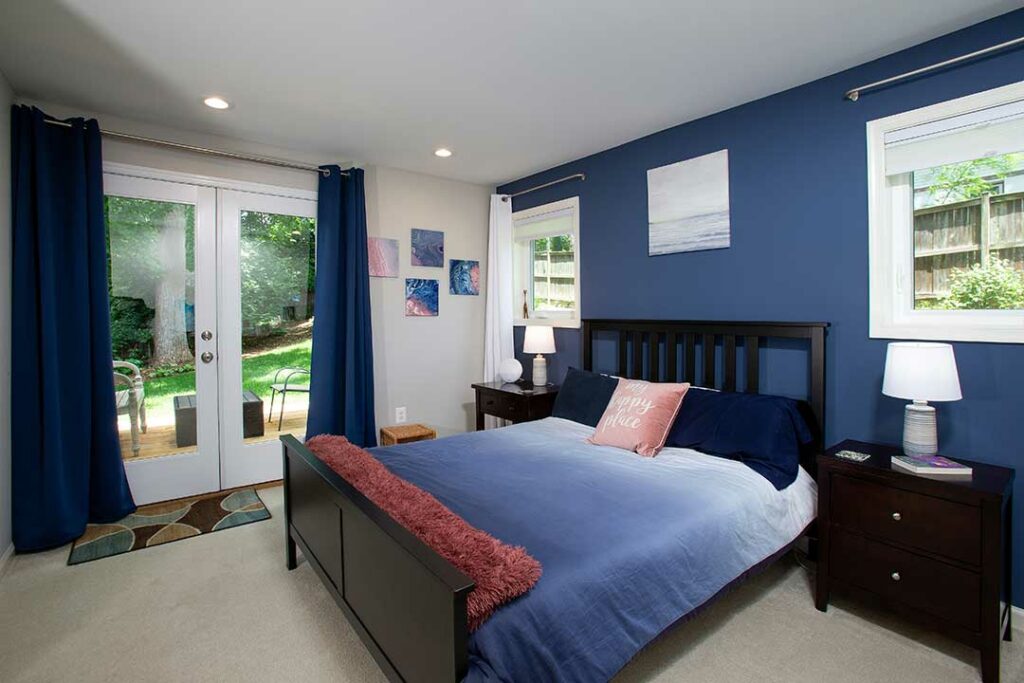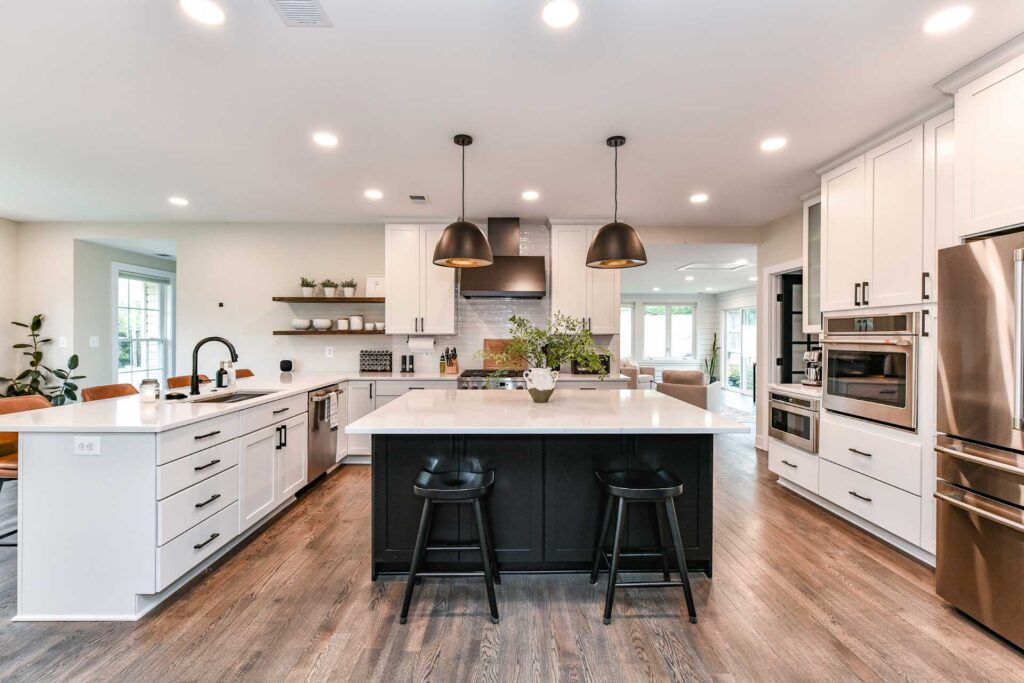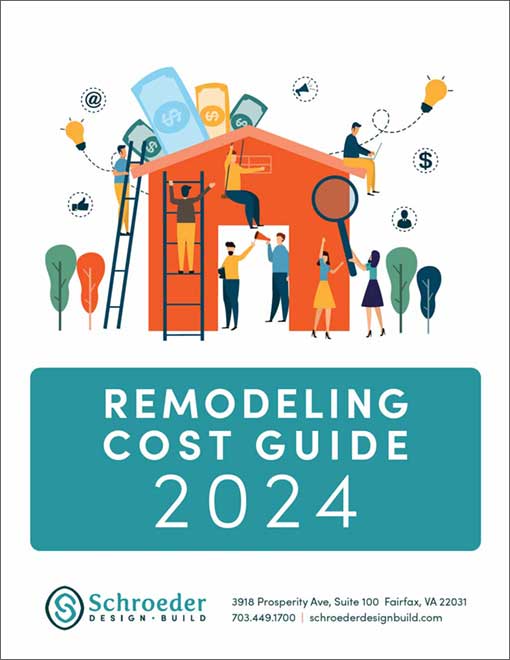As more families seek to create ways to live, save and support one another, multigenerational living is becoming an increasingly popular solution. Whether it’s aging parents moving in with adult children or younger generations returning home, today’s households are evolving to reflect a deeper sense of connection and practicality. For many, sharing a home across generations is a smart, intentional way to navigate changing financial, emotional and caregiving needs. In this post, we’ll explore how multigenerational living can help you save money and how thoughtful remodeling can help your family thrive together.
“When families come to us exploring multigenerational living, they’re looking for more than extra space; they’re looking for a way to live together comfortably without giving up privacy, independence, or their lifestyle,” explains Jim Baker, General Manager and Director of Design at Schroeder Design Build. “Our role is to help them design a home that brings people closer while still giving each generation room to breathe.”
Why More Families are Choosing Multigenerational Living
More Americans than ever are embracing multigenerational living. In fact, nearly 60 million people in the U.S. now live in a household containing two or more adult generations. While this trend is shaped by cultural traditions or evolving family dynamics, saving money is one of the most powerful motivators.
When multiple generations share a home, it reduces the financial burden that can come with independent living. Cost sharing on food, bills and maintenance can be distributed across generations, which not only lowers individual expenses, it creates a sense of mutual support and financial collaboration.
Beyond finances, multigenerational households offer emotional and social benefits. Older adults gain companionship, which helps combat loneliness. And children receive more attention, guidance and care from grandparents and an extended community. Together, these shared experiences strengthen bonds and provide a deeper sense of community. In addition, multigenerational living provides flexibility for evolving family needs, allowing families to support one another through life’s transitions that can range from childcare and eldercare to transitional housing and long-term lifestyle planning.
“Multigenerational remodeling is really about creating balance—balancing shared spaces with private ones, accessibility with beauty, and the needs of older adults with the routines of growing families,” Baker says.
How Multigenerational Living Meets Diverse Financial Needs

The financial realities of adulthood are diverse and ever-changing. Older adults may prioritize medical bills, mortgage stability or maximizing their retirement savings. Younger adults may face challenges including student loan debt, high housing costs and the goal of saving for their own first home.
In multigenerational homes financial responsibilities are distributed across family members to create a financial safety net. Sharing costs for groceries, transportation and utilities helps families weather economic uncertainty, and from job loss and inflation to medical emergencies, a multigenerational setup allows households to be more resilient. Even better, pooled funds can be redirected toward long-term financial goals like higher education, investments or secure future housing.
Financial Benefits for Multigenerational Living for Younger Adults
For young adults, moving back into the family home is increasingly common—and can be a smart decision. Sixty-eight percent of young adults in multigenerational households live in a parent’s home. And they’re not freeloading—they’re contributing. On average, they contribute 22% of the total household income, and if they are head of household, that number jumps to 37%.
Young adults may be weighed down by student loan debt, high housing costs and lower starting wages. Especially if they don’t have a college degree. Rising living costs make it harder to live independently, particularly early in their career. Multigenerational living with parents or grandparents offers financial support and opportunity, allowing younger adults to save money, pay off debt, build credit or save funds for a down payment or retirement. For many younger people, multigenerational living is a longer-term strategy that provides breathing room while still allowing for growth, contribution and independence.
Financial Support and Shared Responsibilities for Older Adults

The multigenerational living trend isn’t limited to younger generations. More older adults are moving in with family, with 6.5% of adults over age 65 now living in multigenerational households. Among these, 20% of women and 15% of men have opted for this arrangement. Rising living costs, expensive health care and limited access to affordable housing are big reasons behind this shift.
For older adults, moving in with family can free up money for healthcare, prescriptions and retirement planning. With fewer than 15% of adults over age 75 able to afford both housing and long-term care on their own, shared living is a smart financial move.
Older adults can contribute financially too. They can help with covering mortgage payments, household expenses or even provide childcare for grandchildren. This mutually beneficial relationship helps ease the financial and caregiving load on everyone.
How Multigenerational Living Can Help Save Money
At its core, multigenerational living is about saving money by sharing life’s expenses. From the mortgage to groceries, sharing a home reduces per-person costs across the board. Utilities, Internet, insurance and home maintenance are all less expensive when divided among more adults.
And it’s not just about cutting costs. It’s about reclaiming time and balance in one’s life. With more family members under one roof, adults (especially parents) often find it easier to balance work and caregiving. This flexibility allows them to pursue full-time jobs, education or career growth without sacrificing the quality of care for their children or aging parents.
Cost Sharing in Multigenerational Households

blog tax savings 104109333
Sharing costs means lightening the load. Families in multigenerational homes work together to cover expenses like the mortgage, rent, utilities, groceries and property taxes. The result is that everyone saves money while maintaining a better standard of living.
Each generation may contribute differently, depending on their income and life stage. For example, parents or grandparents may cover housing expenses, while adult children pay for food and utilities. This kind of financial alignment mimics thoughtful home design, as in a remodel where every element supports real-life priorities.
Pooling resources also unlocks bulk buying, shared service plans and reduced per-unit costs. Whether you’re splitting the cost of landscaping or buying family-sized groceries, multigenerational families can stretch every dollar further.
Managing Elder Care in Multigenerational Homes
Often, older adults move in with family due to a life transition like widowhood, divorce or declining health. Others are motivated by a desire for companionship and emotional support. Whatever the reason, caregiving becomes a shared responsibility.
Elder care brings both emotional and financial challenges. Family members can contribute by covering medical expenses, handling transportation or being hands-on with daily care. In addition, the house itself may need to be remodeled to ensure the safety and comfort of older family members, with home modifications like grab bars, wider doorways and walk-in showers and a first-floor suite, or outdoor additions like non-slip walkways or ramps.
These improvements are a worthwhile investment, and their costs can often be shared among family members or paid for by the elder adult(s) if possible. Reviewing long-term care insurance policies can help clarify what services are covered and how a family can minimize out-of-pocket costs.
When older parents can cover their own personal expenses, such as food, healthcare and personal items, multigenerational living promotes autonomy while easing the financial pressure on adult children. For those providing extensive support, it’s smart to keep receipts. Certain caregiving expenses may qualify for tax deductions or tax credits; you may be able to claim a parent as a dependent, deduct unreimbursed medical expenses, or qualify for a Child and Dependent Care Credit.
Childcare Support in Multigenerational Living

Childcare is another significant financial factor. Roughly 12% of adults in multigenerational households cite caregiving for children as the reason for living together. Having grandparents or older family members helping with childcare can save a family thousands of dollars a year.
Whether it’s watching toddlers during work hours, handling school drop-offs/pickups or providing after-school or weekend care, this shared effort dramatically reduces daycare and babysitting expenses. It also allows parents to take on more demanding jobs with higher pay or travel requirements, return to work earlier after having a child or simply enjoy a much-needed break while knowing their children are in capable hands.
Children benefit too. Daily interaction with grandparents or extended family offers emotional security, a sense of belonging, guidance and help with schoolwork or life skills. For older adults, it fosters a sense of purpose and keeps them engaged.
When Multigenerational Living Makes Financial Sense
Multigenerational living is a smart financial move, but it’s most successful under the right circumstances. Families thrive when there’s enough living space, clear expectations and strong communication. Establishing guidelines about expenses, caregiving duties and boundaries ensures that the arrangement supports relationships and supports privacy and dignity.
Still, there are challenges. Overcrowded spaces can create tension, and caregiving can take an emotional toll. If families avoid financial discussions or lack mutual respect, the setup could fall apart. While more than 50% of multigenerational households say the experience is rewarding, about 25% report ongoing stress. Younger adults often feel the most tension, while older adults generally find the situation more positive.
One of the most effective ways to reduce stress? A good home design, with smart design choices like dual-purpose areas, and a separate living suite and entrance.
Solving Space, Stress & Caregiving Challenges Through Whole Home Remodeling

“Multigenerational living works best when the home is designed to reflect how people really live. That means understanding the rhythms of daily life—who’s up early, who works late, who needs quiet time, and who needs extra support,” Baker says. “Good design takes all of that into account.”
Often, the key to making multigenerational living work is a thoughtfully remodeled home. Families may struggle not because of the shared living arrangement, but because the home wasn’t designed for multigenerational living. Whole home remodeling solves this problem by customizing your space to meet everyone’s needs. Think about a private in-law suite, an expanded kitchen, additional bathrooms or an open-concept layout that fosters connection while preserving privacy.
For families needing even more room, home additions like a new bedroom wing, sunroom or second story expansion create dedicated spaces for growing families, aging parents or returning adult children. These upgrades help you avoid the cost and stress of moving and allow you to prepare your home for future needs.
Accessibility remodeling also supports aging in place, with features like walk-in showers, non-slip flooring and zero-threshold entries making the home safer and more functional. Creating a first-floor owner’s suite eliminates the need for stairs, for both independence and caregiver relief.
Ultimately, intentional design reduces household tension, improves quality of life and enhances your home’s long-term resale value. So, for families considering multigenerational living, the right remodel can turn a good idea into a lasting solution—financially, emotionally and practically.
Start Your Northern Virginia Remodeling Journey with Confidence, with Schroeder Design Build
“We’re not here to give families a one-size-fits-all solution,” Baker says. “Every project we take on is rooted in listening—to what’s working, what’s not, and what a family hopes their future can look like under one roof. That’s where our design process begins.”
When you’re planning to remodel to support multigenerational living, you need more than a contractor. You need a partner who understands how to design for both function and family. Schroeder Design Build brings decades of experience in creating customized spaces for Northern Virginia homeowners that work beautifully for every generation under your roof. From open-concept layouts to private in-law suites, our team prioritizes comfort, flexibility and the smart use of space.
The Schroeder approach is deeply collaborative. We guide our clients through every stage of the remodeling process, from initial concept and design to construction and finishing touches with an integrated design model that ensures your remodel is cohesive, on budget and tailored to your family’s unique needs.
With a reputation built on trust, transparency and exceptional craftsmanship, Schroeder Design Build empowers you to begin your remodeling journey with confidence. Contact us for a complimentary consultation where you’ll explore your vision with experts in how to turn your ideas into reality.
“There’s no denying that multigenerational living comes with its challenges,” Baker explains. “But with the right layout, the right features and the right guidance, it can also be one of the most supportive and rewarding ways to live.”
Contact Schroeder Design Build

For those considering multigenerational living, the right home design can make all the difference. Contact us today to schedule your initial consultation and discover what’s possible for your multigenerational home.
Want to learn more about remodeling? Sign up for our newsletter.
And check out our portfolio of whole house remodels.


